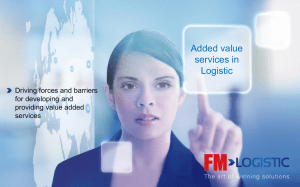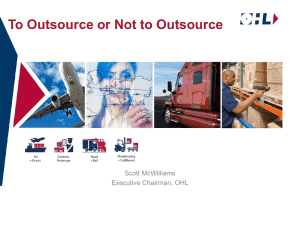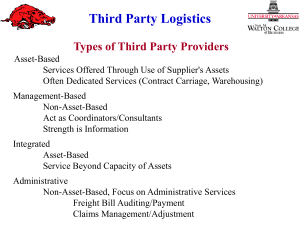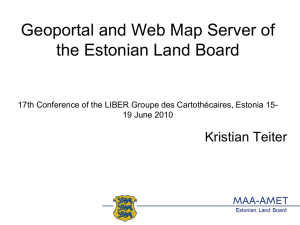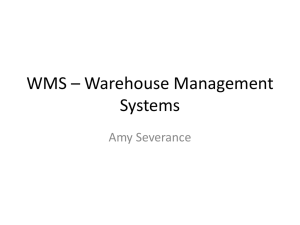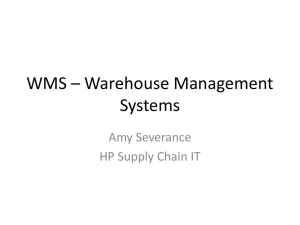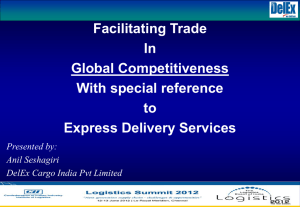Warehouse Management Systems for 3PL Providers
advertisement
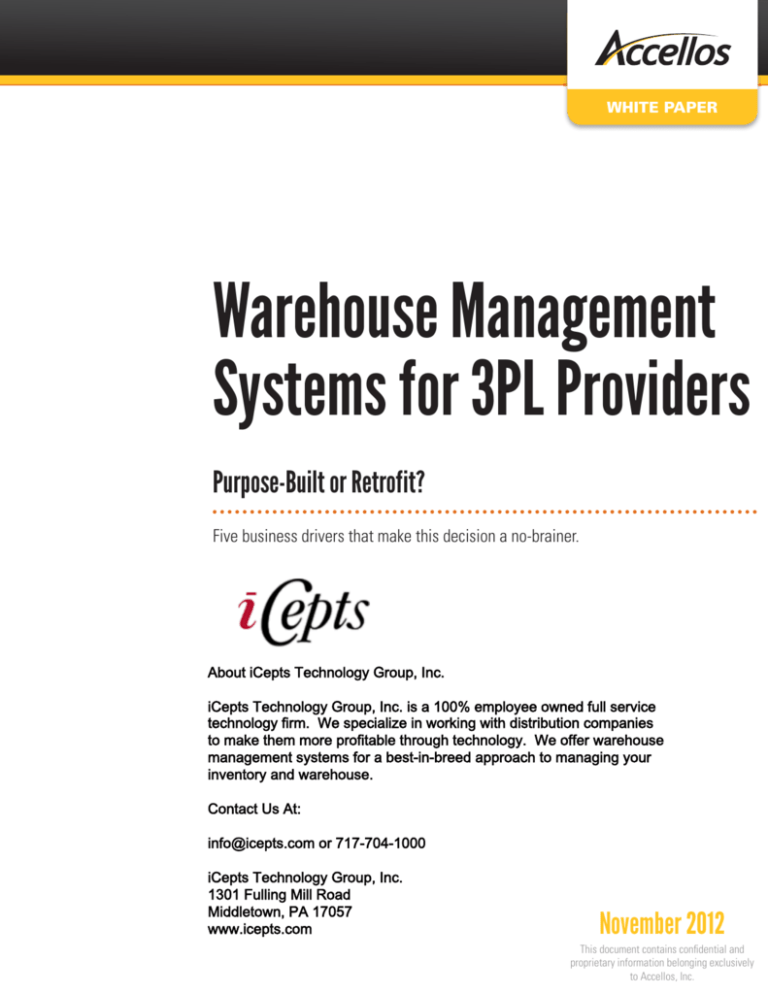
WHITE PAPER Warehouse Management Systems for 3PL Providers Purpose-Built or Retrofit? Five business drivers that make this decision a no-brainer. About iCepts Technology Group, Inc. iCepts Technology Group, Inc. is a 100% employee owned full service technology firm. We specialize in working with distribution companies to make them more profitable through technology. We offer warehouse management systems for a best-in-breed approach to managing your inventory and warehouse. Contact Us At: info@icepts.com or 717-704-1000 iCepts Technology Group, Inc. 1301 Fulling Mill Road Middletown, PA 17057 www.icepts.com November 2012 This document contains confidential and proprietary information belonging exclusively to Accellos, Inc. www.icepts.com WHITE PAPER WAREHOUSE MANAGEMENT SYSTEMS FOR 3PL PROVIDERS Purpose-Built or Retrofit? Five business drivers that make this decision a no-brainer Introduction Third Party Logistics (3PL) providers make their living performing outsourced functions for their clients. They sell their clients on the value of focusing on one’s core competencies and leaving other functions to the experts. Historically, 3PL’s have not always practiced what they preach; many built and maintained their own IT systems with the thought being, “No software provider could possibly understand the complexities of our business model; therefore, a packaged solution will never meet our requirements.” In recent years that philosophy has shifted. The complexity of operating a third party logistics facility, particularly one that serves multiple clients, has accelerated. As new clients come on board, or existing clients put forth new requirements, 3PL’s must react quickly while protecting their own bottom line. More and more, 3PL’s have realized that building and maintaining mission critical IT systems can be a drain on company resources and instead are partnering with solution providers to enhance their IT capability. Bottom line…3PL’s are now practicing what they preach. When selecting a Warehouse Management System (WMS), 3PL executives face a seemingly endless number of options. It’s undoubtedly a challenge to sift through all of these options and come to the right decision for their company. Arguably, the most important question to answer in this process is whether to select a solution that is purpose-built for their industry or to select one that has been retrofitted for a multi-client, 3PL environment. While this is clearly an important decision, one may ask… purpose-built versus retrofit… is this a trick question? Why would one ever consider a retrofit over something that is purpose-built? It’s not likely that you would be comfortable driving a car that was retrofitted with a go-cart engine. However, as crazy as the question may sound, perhaps the following scenario can shed some light on its relevance and it may even hit close to home. Your premier client, XYZ Corporation, has learned that you are in the market for a new WMS. In the spirit of collaboration, they provide some advice that will save you from having to go through the tedious process of a software selection. The WMS that is used in their own manufacturing DC’s also happens to have a version that can work in 3PL facilities. Their vendor has assured them that their base WMS has been enhanced to include multi-client capabilities and that the functionality can easily be “switched on.” And why not take advantage of the “seamless” integrations that would be present if both client and 3PL are on the “same” system? While it may be tempting for a 3PL executive to succumb to the urgings of their largest client, it could very well turn out to be a disastrous decision. This white paper will outline the five business drivers that confirm the executive’s instinct… the only sound decision is to select a WMS that is purpose-built for their industry. Business Driver #1 – Inventory Integrity As a 3PL provider, you are charged with managing the integrity of perhaps your client’s most valuable asset, their inventory. This is something you do not take lightly. You know all too well that poor inventory integrity can lead to missed sales and shrinkage for your clients as well as hundreds of hours in lost time for your staff as they perform reconciliation activities and problem resolution. When maintaining inventory for multiple clients under one roof, the challenge is even more daunting. It is common for a 3PL provider to manage clients in the same facility that have overlapping identifiers such as, item codes or pallet codes. A purpose-built WMS will be architected to include concatenation of these key codes with the client ID to provide a truly unique identifier. Retrofitted systems built from a single customer www.icepts.com WHITE PAPER distribution model are challenged by this seemingly basic concept. As a result, a customization or workaround is required adding cost and risk to the implementation. Even if the problem can be solved through a customization or workaround, there aren’t many distribution managers that relish the thought of relying on this approach. To compensate for this reduced confidence in the system, they often use manual processes to validate the accuracy of the work performed. This adds cost to the operation and compromises the purpose of using an automated system to manage inventory. Employing a purpose-built system designed to meet this challenge ensures that inventory integrity is sound. Accuracy breeds confidence and enables clients to reduce their inventory levels (and thus the carrying costs) through the reduction of safety stock. Accuracy will also ensure that there are minimal shipping errors and out-of-stocks reducing costs for the client and increasing their customer’s satisfaction. Business Driver #2 – Customer Service Enablement Just as you are focused on providing exceptional customer service to your clients, your clients strive for the same with their own customers. A high standard of customer service not only means meeting your client’s core requirements, it also means providing the right tools that will foster innovation and enable your customers to proactively manage their business. Here again a purpose-built WMS is vital to your success. A purpose-built WMS is architected for a multi-client environment. Often deployed using a single instance and database serving multiple clients, the data model is built to ensure that each client will only be able to access their own information. So, in addition to providing real-time information on inventory, shipments and other key activity, you will be able to provide your clients with self-service access to this information while maintaining data security between clients. Another key element in ensuring a high level of customer service is to provide the ability to setup exception alerting. Each client will have their own opinions as to which activities warrant automated alerting and a purpose-built system will enable the creation of alerts that are unique to each client. This will give clients the visibility necessary to address a potential issue before it becomes damaging to the business. The above capabilities not only ensure that the level of customer service is raised, but they also drive down the overall all cost of customer service through automation. Bottom line, it enables all parties to manage the business proactively rather than reactively. Business Driver #3 – Concurrent Client Logistics What is concurrent client logistics? At its core, concurrent logistics is the ability to efficiently manage multiple clients in the same building, using shared resources; all while maintaining inventory integrity, data security, and ensuring that client specific workflows are performed timely and accurately. It is difficult to overstate the importance of operational efficiency for 3PL providers. If they are not able to take advantage of shared resources (e.g. people, equipment, and space) across clients and to be able to shift those resources seamlessly, they will not maintain an adequate level of profitability or be able to grow the business. Take the example of an operation that cannot share resources easily. As volumes ebb and flow for each client, the result is reduced efficiency and lost time. By the time management realizes there is an imbalance, one group may have been idle or working below capacity while another is stretched thin. When a shift in resources is finally initiated, there will be lost time while the operators change equipment, receive instructions, and change to the new work queue. A purpose-built WMS will enable the 3PL provider to maintain a single work queue across multiple clients, enabling the interleaving of tasks based on the proximity and priority of work. Work will be assigned based on a holistic view of the operation thus maximizing efficiency. In public, multi-client warehousing, space is a premium. Wasted space is lost revenue. Concurrent logistics enables the co-mingling of client products, utilizing the correct rack type and size for each pallet and product. Without this capability, the warehouse will need to have designated areas for each client. As a client’s volume changes, the space allocation for each client will have to change to avoid unused space. However, to accomplish this, non-revenue generating product movements will be required. This creates a trade-off decision not many managers want to face. www.icepts.com WHITE PAPER The ability to flawlessly execute the myriad client requirements is arguably the greatest challenge 3PL providers face. Each client will have unique procedures for the processing of their shipments such as value added services, unique documentation, and EDI transactions to name a few. A purpose-built WMS for the 3PL industry can ensure that all of these requirements are handled automatically and accurately. By having these client specific workflows built into the framework of the system (and giving the provider the ability to create and modify workflows on their own), it is assured that the work will be performed every time and at the most efficient point in the process thus increasing efficiency and reducing costs. Business Driver #4 – Revenue Assurance In the complicated world of delivering 3PL services in a multi-client environment, it is no small task to track the revenue producing activities each day. Further complicating matters, there may be multiple revenue models in a single operation where each client’s activity must be tracked and billed in a unique way. If these items aren’t tracked accurately, or if the required backup details cannot be easily provided, it is too easy to miss billable activity and its associated revenue stream. With a purpose-built WMS, this core 3PL function is woven into the fabric of the system. Activities are tracked and the appropriate data stored for invoicing purposes as a natural extension of the work performed. In the case of a retrofitted WMS that historically did not require billing functionality and activity tracking, a billing system must be “bolted on” and interfaced to the WMS. Here, there is often a mismatch in the data models and without significant configuration and customized billing rules, manual steps and validation will be required. With the purpose built system, not only will revenue realization be assured, but also the effort to summarize the appropriate information and to generate invoices will be far lower. Because activity is tracked automatically when a task is performed, it is certain that the correct data elements will be tracked to ensure accurate billing and revenue recognition. An additional benefit of having this core activity as an integral part of the system is that it enables 3PL providers to create timely, accurate bids on new business or requirements. It also enables them to perform true activity based costing so that they can evaluate the profitability of each client. There is such a thing as bad business, and in the case of a 3PL provider, it is an unprofitable client. The activity based costing capability inherent in a purpose-built system will ensure that the right cost is charged for all activity and that profitability is maintained. Business Driver #5 – Beyond the Four Walls The first four business drivers have focused primarily on what occurs within the four walls of the 3PL facility. Of course, it does not end there. There are a number of critical interactions between client, 3PL, client suppliers, and client customers that occur outside of the four walls. These activities include tasks such as transportation management and supplier management, and must be considered in any WMS purchase decision. The benefits of moving goods efficiently within the four walls of the warehouse will be quickly eroded if a company overpays to move goods in and out of the facility. Given that this requires the management of routing rules and requirements for multiple clients, the task cannot be effectively completed without a transportation management system (TMS). A purpose-built WMS will be an enabler to solid integration to a TMS, leveraging the data model that has client specific information, including their unique routing requirements. Operating a purpose-built WMS provides 3PL providers with access to large volumes of data delineated by clients that can be leveraged and transformed into valuable business information. For example, as inbound product is received from a client’s suppliers, or their own manufacturing facilities, data that is key to business success can easily be accessed. This data can be transformed into a supplier scorecard and the client will be able to make informed decisions regarding which suppliers to purchase from or which manufacturing facilities in their own network are performing effectively. So, although many 3PL to client relationships have traditionally been contained within the four walls, many 3PL providers are evolving into 4PL providers that manage the broader, end-to-end process. The above examples illustrate that using a purpose-built WMS provides the opportunity to leverage technology to extend the relationship and manage a wider spectrum of services. www.icepts.com WHITE PAPER Don’t Fall Victim to the “IT Gap” As highlighted each year in The Annual 3PL Study, 1 there is a persistent “IT Gap” that exists between the level of importance that clients place on third-party logistics provider’s IT capability and their satisfaction with the current capabilities of the providers. For several years, this gap has hovered around 40 percent, indicating that clients are less than satisfied with the IT capability of their service providers. The report also confirms that clients look at IT capability to be at the core of the 3PL’s ability to provide value. So why the persistent gap? Some of this gap may be explained by 3PL providers not adequately leveraging the capabilities that they do have when providing services for their clients. However, given that there are 3PL providers using retrofitted systems rather than a system purposebuilt for their industry, it is not surprising that a gap exists. With a retrofitted system, it becomes too time consuming and costly to meet new client requirements resulting in a limited IT capability. There is a strong desire in the industry from all parties to leverage IT more strategically to reduce cost, increase efficiencies and drive innovation. Third party logistics providers must avoid falling victim to the “IT Gap.” Instead, they should employ a system that has been architected from the ground up and uses a data model that was developed with 3PL requirements at its core. This will provide them with the opportunity to close the gap and provide real value to their clients…something that will in turn generate more business for their company. Summary It is not difficult to grasp the importance of the five business drivers outlined in this white paper. For those that are IT savvy, the details of the architecture and data model will also be of interest. What is relevant to everyone however, is that unless the system has been architected from the ground up and purpose-built for a multi-client environment, the data model will be a limiter rather than an enabler. In addition to the aforementioned benefits, the selection of a purpose built system will also provide these additional benefits: ■ Lower hardware and maintenance costs, leveraging a single software instance, truly multi-tenant, environment. ■ Reduced risk in rolling out new requirements and new clients where a change to one client’s workflows won’t impact another’s. ■ Increased competitive advantage in the industry by leveraging technology to foster innovation. ■ Collaboration with industry experts that have designed and developed the purpose-built WMS. Given the clear benefits discussed in this white paper, the choice is a no-brainer. Only a purpose-built WMS will help 3PL providers to close the “IT Gap” and deliver innovation and value to their clients. 1 – 2013 Third-Party Logistics Study, The State of Logistics Outsourcing – Capgemini Consulting; Dr. C. John Langley, Penn State University; Panalpina; Korn/Ferry International; Eye for Transport ABOUT ACCELLOS Accellos is a global provider of software solutions specifically designed for the unique needs of logistics service providers and small and midsized businesses (SMB). Over 3,000 companies trust Accellos to be the technology backbone of their global supply chains. Accellos provides solutions for warehouse management systems (WMS), third party logistics (3PL), fleet management, transportation management systems (TMS), trading partner integration (EDI), automated barcode data collection, parcel shipping, transportation optimization and supply chain business intelligence. Accellos solutions are built on the AccellosOne platform, a modern technology platform featuring a user-friendly interface and simplified technical administration. FOR MORE INFORMATION: email info@accellos.com or visit www.accellos.com © 2012, Accellos, Inc. WMS for 3PL White Paper 12.7.2012
